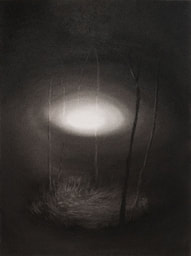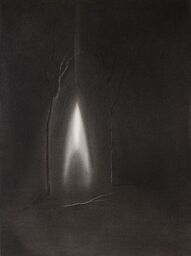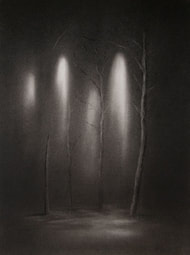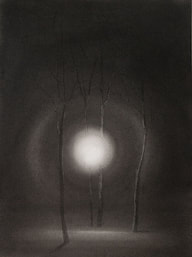Phenomenon series | 2023 | 26,5cm x 35,5cm
Romantiek en Verlichting
Het rationele denken vindt haar oorsprong in de Verlichting. De wetenschappelijke
vooruitgang die gebaseerd is op de overtuiging dat er geen geheimzinnige machten meer
zijn en dat we alles door berekening kunnen beheersen, werd door Max Weber omschreven
als ‘onttovering’. Tegenover de moderne wereld waar geen plaats meer is voor het mystieke
en diepe gevoelens, manifesteerde zich in de 19de eeuw de romantische tegenbeweging op
zoek naar de poëzie, het spirituele en de schoonheid, kortom dat wat niet ontleed kan
worden. Kevin Vanwonterghem exploreert het landschapsgenre in het spoor van de
romantiek. Wat zich bevindt in de schemerzone tussen het mystieke en het verklaarbare is
zijn inspiratiebron. Net als bij de romantici, kent hij de kunst een cruciale rol toe. Zijn
landschappen zijn niet topografisch, eerder dystopisch van aard – een soort surrealistische
setting waar ruimte is voor ‘betovering’. In zijn reeks Phenomena tekent hij uiteenlopende
lichtverschijnselen, waarin de menselijke aanwezigheid steevast ontbreekt. De kale kruinen
van de boompjes baden in een atmosferisch licht, in andere houtskooltekeningen wordt het
fluwelen karakter van de diepe zwarttonen letterlijk opgelicht. Als kijker participeer je in
deze taferelen, de enigmatische lichteffecten nodigen je uit om in Vanwonterghems
landschappen te stappen. Ingrid Van Hecke , Kunsthistorica en directrice Husk Gallery | mei 2024
Romanticism and Enlightenment
Rational thinking has its origins in the Enlightenment. Scientific progress, based on the conviction that there are no more mysterious powers and that we can control everything by calculation, was described by Max Weber as 'disenchantment'. Against the modern world where there is no more room for the mystical and deep feelings, the 19th century saw the manifestation of the romantic counter-movement in search of poetry, the spiritual and beauty, in short that which cannot be parsed. Kevin Vanwonterghem explores the landscape genre in the wake of Romanticism. Whatever is in the twilight zone between the mystical and the explicable is his inspiration. Like the romantics, he assigns a crucial role to art. His landscapes are not topographical, rather dystopian in nature - a kind of surreal setting where there is room for 'enchantment'. In his Phenomenon series, he draws diverse light phenomena, in which human presence is invariably absent. The bare treetops of trees are bathed in atmospheric light; in other charcoal drawings, the velvety nature of the deep black tones is literally lit up. As a viewer, you participate in these scenes, the enigmatic light effects invite you to step into Vanwonterghem's landscapes.
Ingrid Van Hecke | Art historian and director of Husk Gallery
Romantisme et Lumières
La pensée rationnelle trouve son origine dans le siècle des Lumières. Le progrès scientifique fondé sur la conviction qu'il n'y a plus de puissances mystérieuses et que nous pouvons tout contrôler par le calcul a été décrit par Max Weber comme un "désenchantement". Face à un monde moderne où il n'y a plus de place pour le mystique et les sentiments profonds, le XIXe siècle a vu se manifester le contre-mouvement romantique à la recherche de la poésie, du spirituel et de la beauté, bref de ce qui ne peut être disséqué. Kevin Vanwonterghem explore le genre du paysage dans le sillage du romantisme. Tout ce qui se trouve dans la zone crépusculaire entre le mystique et l'explicable l'inspire. Comme les romantiques, il attribue un rôle crucial à l'art. Ses paysages ne sont pas topographiques, mais plutôt de nature dystopique - une sorte de décor surréaliste où il y a de la place pour l'"enchantement". Dans sa série Phenomena, il dessine divers phénomènes lumineux, dans lesquels la présence humaine est invariablement absente. Les cimes dénudées des arbres baignent dans une lumière atmosphérique ; dans d'autres dessins au fusain, la nature veloutée des tons noirs profonds est littéralement éclairée. En tant que spectateur, vous participez à ces scènes, les effets de lumière énigmatiques vous invitent à pénétrer dans les paysages de Vanwonterghem.
Ingrid Van Hecke, Historienne de l’art et directrice Husk Gallery
Het rationele denken vindt haar oorsprong in de Verlichting. De wetenschappelijke
vooruitgang die gebaseerd is op de overtuiging dat er geen geheimzinnige machten meer
zijn en dat we alles door berekening kunnen beheersen, werd door Max Weber omschreven
als ‘onttovering’. Tegenover de moderne wereld waar geen plaats meer is voor het mystieke
en diepe gevoelens, manifesteerde zich in de 19de eeuw de romantische tegenbeweging op
zoek naar de poëzie, het spirituele en de schoonheid, kortom dat wat niet ontleed kan
worden. Kevin Vanwonterghem exploreert het landschapsgenre in het spoor van de
romantiek. Wat zich bevindt in de schemerzone tussen het mystieke en het verklaarbare is
zijn inspiratiebron. Net als bij de romantici, kent hij de kunst een cruciale rol toe. Zijn
landschappen zijn niet topografisch, eerder dystopisch van aard – een soort surrealistische
setting waar ruimte is voor ‘betovering’. In zijn reeks Phenomena tekent hij uiteenlopende
lichtverschijnselen, waarin de menselijke aanwezigheid steevast ontbreekt. De kale kruinen
van de boompjes baden in een atmosferisch licht, in andere houtskooltekeningen wordt het
fluwelen karakter van de diepe zwarttonen letterlijk opgelicht. Als kijker participeer je in
deze taferelen, de enigmatische lichteffecten nodigen je uit om in Vanwonterghems
landschappen te stappen. Ingrid Van Hecke , Kunsthistorica en directrice Husk Gallery | mei 2024
Romanticism and Enlightenment
Rational thinking has its origins in the Enlightenment. Scientific progress, based on the conviction that there are no more mysterious powers and that we can control everything by calculation, was described by Max Weber as 'disenchantment'. Against the modern world where there is no more room for the mystical and deep feelings, the 19th century saw the manifestation of the romantic counter-movement in search of poetry, the spiritual and beauty, in short that which cannot be parsed. Kevin Vanwonterghem explores the landscape genre in the wake of Romanticism. Whatever is in the twilight zone between the mystical and the explicable is his inspiration. Like the romantics, he assigns a crucial role to art. His landscapes are not topographical, rather dystopian in nature - a kind of surreal setting where there is room for 'enchantment'. In his Phenomenon series, he draws diverse light phenomena, in which human presence is invariably absent. The bare treetops of trees are bathed in atmospheric light; in other charcoal drawings, the velvety nature of the deep black tones is literally lit up. As a viewer, you participate in these scenes, the enigmatic light effects invite you to step into Vanwonterghem's landscapes.
Ingrid Van Hecke | Art historian and director of Husk Gallery
Romantisme et Lumières
La pensée rationnelle trouve son origine dans le siècle des Lumières. Le progrès scientifique fondé sur la conviction qu'il n'y a plus de puissances mystérieuses et que nous pouvons tout contrôler par le calcul a été décrit par Max Weber comme un "désenchantement". Face à un monde moderne où il n'y a plus de place pour le mystique et les sentiments profonds, le XIXe siècle a vu se manifester le contre-mouvement romantique à la recherche de la poésie, du spirituel et de la beauté, bref de ce qui ne peut être disséqué. Kevin Vanwonterghem explore le genre du paysage dans le sillage du romantisme. Tout ce qui se trouve dans la zone crépusculaire entre le mystique et l'explicable l'inspire. Comme les romantiques, il attribue un rôle crucial à l'art. Ses paysages ne sont pas topographiques, mais plutôt de nature dystopique - une sorte de décor surréaliste où il y a de la place pour l'"enchantement". Dans sa série Phenomena, il dessine divers phénomènes lumineux, dans lesquels la présence humaine est invariablement absente. Les cimes dénudées des arbres baignent dans une lumière atmosphérique ; dans d'autres dessins au fusain, la nature veloutée des tons noirs profonds est littéralement éclairée. En tant que spectateur, vous participez à ces scènes, les effets de lumière énigmatiques vous invitent à pénétrer dans les paysages de Vanwonterghem.
Ingrid Van Hecke, Historienne de l’art et directrice Husk Gallery



